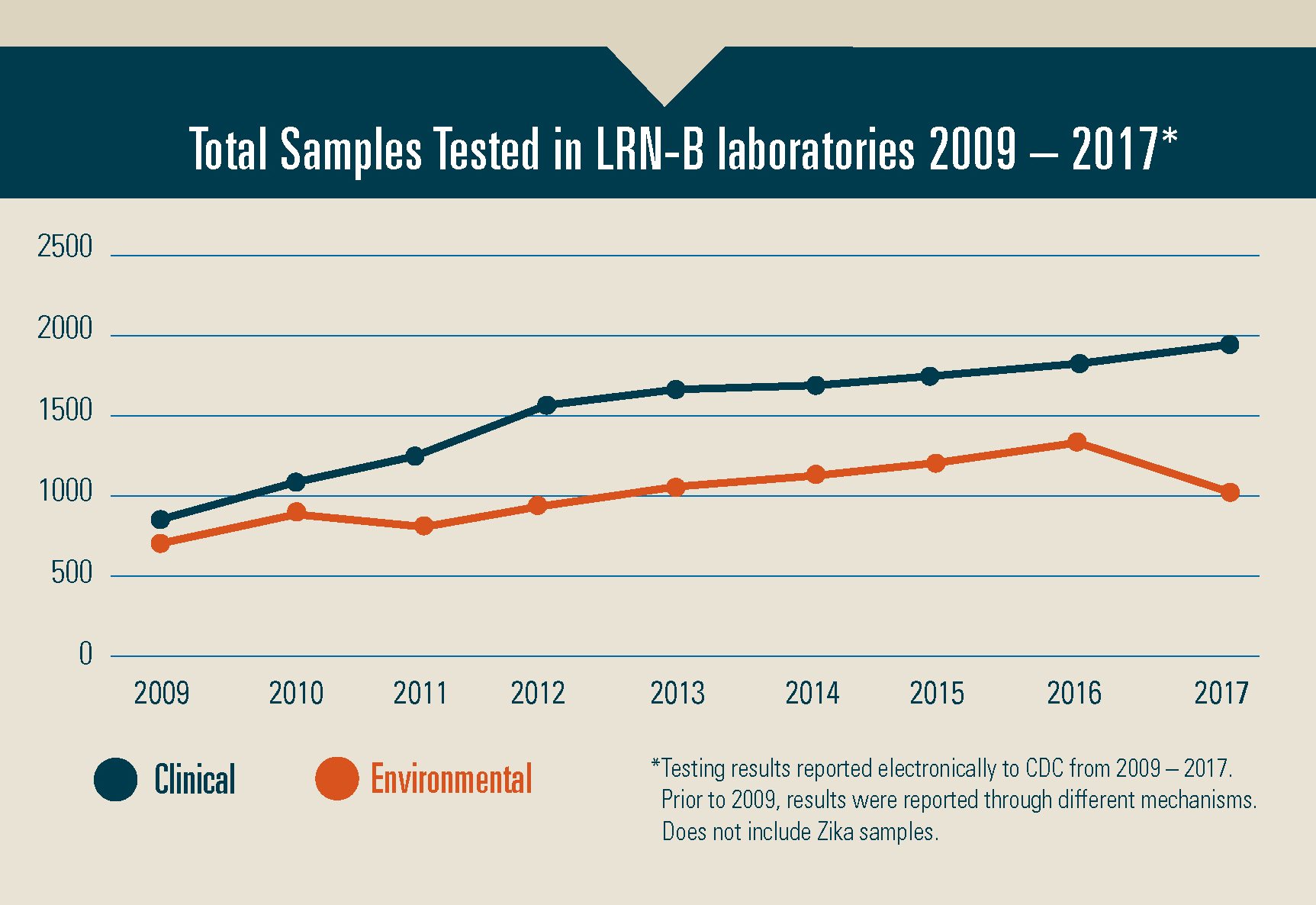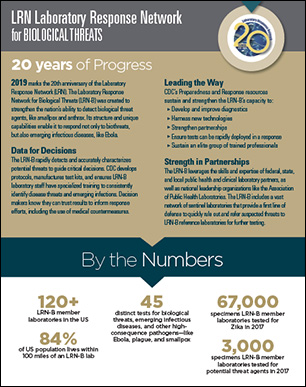20 Years of Progress: Laboratory Response Network for Biological Threats

2019 marks the 20th anniversary of the Laboratory Response Network (LRN). The Laboratory Response Network for Biological Threats (LRN-B) was created to strengthen the nation’s ability to detect biological threat agents, like smallpox and anthrax. Its structure and unique capabilities enable it to respond not only to biothreats, but also emerging infectious diseases, like Ebola.
Data for Decisions
The LRN rapidly detects and accurately characterizes potential threats to guide critical decisions. CDC develops protocols, manufactures test kits, and ensures LRN laboratory staff have specialized training to consistently identify disease threats and emerging infections. Decision makers know they can trust results to inform response efforts, including the use of medical countermeasures.
Leading the Way
CDC’s Preparedness and Response resources sustain and strengthen the LRN’s capacity to:
- Develop and improve diagnostics
- Harness new technologies
- Strengthen partnerships
- Ensure tests can be rapidly deployed in a response
- Sustain an elite group of trained professionals
Strength in Partnerships
The LRN leverages the skills and expertise of federal, state, and local public health and clinical laboratory partners, as well as national leadership organizations like the Association of Public Health Laboratories. The LRN-B includes a vast network of sentinel laboratories that provide a first line of defense to quickly rule out and refer suspected threats to LRN reference laboratories for further testing.
- 120+ LRN-B member laboratories in the U.S.
- 84% of U.S. population lives within 100 miles of an LRN-B lab.
- 45 distinct tests for biological threats, emerging infectious diseases, and other high-consequence pathogens—like Ebola, plague, and smallpox.
- 67,000 specimens LRN-B member laboratories tested for Zika in 2017.
- 3,000 specimens LRN-B member laboratories tested for potential threat agents in 2017.

Distinguished Impact
First Line of Defense
From protecting Democratic and Republican National Conventions, Super Bowls, and the Olympics against potential biothreats, to serving as the experts any time a suspicious white powder needs to be tested, the LRN-B stands ready to protect Americans every day. Sustained by Public Health Emergency Preparedness funding, the LRN-B provides reliable results.
Anthrax in New Hampshire
In 2009, the New Hampshire Public Health Laboratory diagnosed a young woman with gastrointestinal anthrax, a very rare illness. The laboratory worked with LRN-B partners to collect, test, and confirm 145 samples, tracing the infection to a drumming event—anthrax spores can be found in animal hides used on drums. Quick work by the laboratory and LRN-B partners meant the patient received an accurate diagnosis and life-saving treatment. It also meant that the community could take steps to prevent further infections.
Ebola in West Africa
During the Ebola outbreak in West Africa, CDC worked with its own scientists and external partners to develop and deploy Ebola laboratory tests into the LRN-B, ensuring the U.S. was prepared and able to test for this deadly pathogen.
Zika
During the recent Zika outbreak, CDC developed and deployed two Zika diagnostic assays to LRN-B reference laboratories across the U.S. From March 2016 through April 2017, LRN-B reference laboratories tested and reported over 90,000 distinct results to CDC—a staggering volume.

1999 – LRN established in 17 laboratories
2001 –Anthrax attacks: LRN activates for first major response
2002 – SARS: CDC develops and deploys new test to LRN-B
2004 – RNC and DNC: LRN-B experts deploy for rapid response
2009 –Anthrax in New Hampshire: quick diagnosis for prevention of additional cases
2012 – MERS: CDC develops and deploys new test to LRN-B
2014 – Ebola: CDC develops and deploys new tests to LRN-B
2016 – Zika: CDC develops and deploys new test to LRN-B
2019 – Over 120 member laboratories in all states

Download the print friendly versionCdc-pdf
[PDF - 408 K]